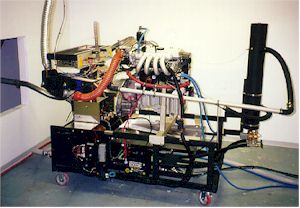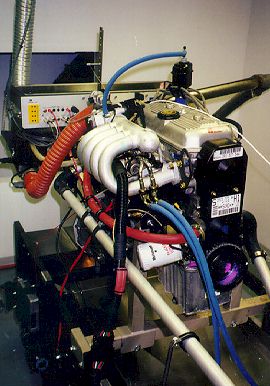SCCA Enterprises Engine Dyno |
||
| SCCA Enterprises now has a new dyno, as seen in these
photographs. Our dynomometer for the Renault engines was totally destroyed in the infamous
fire of ’95 and we have, since then, been out of the engine rebuild and dyno
business.
The new piece is a SuperFlow 901,
(see http://www.Superflow.com/) with
computer and incorporates their WinDyn software Extensive sealing was used at every joint, to provide best sound insulation. Even the electrical boxes were sealed to eliminate any possible sound leaks. An oversize fan draws air through the room, to pull out unwanted fumes. The air source for the engine is outside the room (note the vertical tube from the airbox) and helps provide a more stable source of intake air. The dyno stand utilizes the Roush wiring harness, The clearancing of the inside of the bellhousing to allow the use of the drive plate is a bit of a long story... to put it in a nutshell... it took several hours. Such is the way of doing a prototype dyno. We wanted to use the direct-drive feature of the SuperFlow design, but this was more than I had bargained for.
In order to best test the engine itself, Here’s to Better Racing Through Technology. |
||
| Dave
Liddle, Engine Department Manager/Compliance Director SCCA Enterprises, Inc. |
||
| Rev. 3/25/98 | ||
| Feedback | ||
| I welcome your comments or ideas on this
information. Feel free to drop me a line via “Comments for the
Bro’s”. Barry |
||
 |
||
 for computer control and data gathering. The dyno is
housed in a room specially constructed for dyno operation. The room, per SuperFlow
recommendations, is built using an offset-stud design, to isolate inner walls from outer
walls. All walls are insulated; inner walls having double-layer drywall, including
the ceiling.
for computer control and data gathering. The dyno is
housed in a room specially constructed for dyno operation. The room, per SuperFlow
recommendations, is built using an offset-stud design, to isolate inner walls from outer
walls. All walls are insulated; inner walls having double-layer drywall, including
the ceiling. EEC module and
associated electrics. The bellhousing is the SRF 5-speed, courtesy of California CSR
WinSpec. The adapter from dyno plate to bellhousing is a custom-made part,
fabricated at Innovation Engineering. The direct drive is made possible via another
Innovation Engineering custom-made piece; a “drive plate” which bolts up to the
Ford flywheel.
EEC module and
associated electrics. The bellhousing is the SRF 5-speed, courtesy of California CSR
WinSpec. The adapter from dyno plate to bellhousing is a custom-made part,
fabricated at Innovation Engineering. The direct drive is made possible via another
Innovation Engineering custom-made piece; a “drive plate” which bolts up to the
Ford flywheel. only one intake
manifold and injection unit, one exhaust manifold, one coil pack and plug wires
combination is going to be used. This is the only way to isolate variables in
testing procedures. In this manner, the variables are minimized and HP matching is
best accomplished.
only one intake
manifold and injection unit, one exhaust manifold, one coil pack and plug wires
combination is going to be used. This is the only way to isolate variables in
testing procedures. In this manner, the variables are minimized and HP matching is
best accomplished.